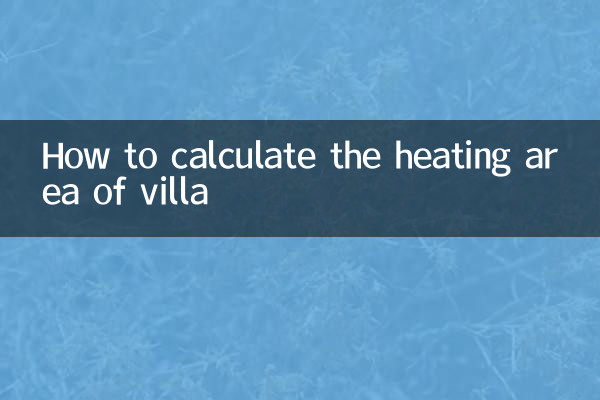How to calculate the heating area of villa
As winter approaches, villa heating issues have become the focus of many owners. How to accurately calculate the heating area and select appropriate heating equipment is not only related to living comfort, but also directly affects energy consumption and expenses. This article will combine the hot topics and hot content on the Internet in the past 10 days to provide you with a detailed analysis of the calculation method of villa heating area, and provide structured data reference.
1. Calculation method of villa heating area

The calculation of the heating area of a villa usually requires the following factors to be considered:
| factors | Description |
|---|---|
| Building area | The building area of the villa is the basis for calculating the heating area, which is usually based on the data on the property certificate or design drawings. |
| actual usable area | The actual usable area after deducting non-heated areas such as walls, stairs, and balconies. |
| Floor height correction coefficient | If the floor height exceeds 3 meters, it needs to be multiplied by a correction factor (usually 1.1-1.3) according to the actual situation. |
| Insulation performance | The thermal insulation performance of the villa (such as wall materials, window sealing) will affect the calculation of the heating area. |
2. Heating area calculation formula
According to industry standards, the calculation formula for heating area is as follows:
| formula | Example |
|---|---|
| Heating area = actual use area × floor height correction coefficient × thermal insulation coefficient | If the actual use area is 200㎡, the floor height correction coefficient is 1.2, and the thermal insulation coefficient is 0.9, then the heating area = 200 × 1.2 × 0.9 = 216㎡. |
3. Area matching of different heating methods
Depending on the heating area of the villa, different heating methods can be selected. The following is a matching table of common heating equipment and applicable areas:
| Heating method | Applicable area (㎡) | Features |
|---|---|---|
| Floor heating | 80-300 | Uniform heat dissipation and high comfort, but the installation cost is high. |
| Central air conditioning | 100-500 | It can be used for both heating and cooling, and is suitable for large-area villas, but it consumes a lot of energy. |
| wall mounted boiler | 50-200 | Flexible installation, suitable for small area or local heating. |
4. Analysis of hot topics on the entire network in the past 10 days
After sorting out the hot spots across the Internet, the following are the recent hot topics related to villa heating:
| topic | focus of discussion |
|---|---|
| “Villa floor heating vs central air conditioning” | Users are concerned about the energy consumption comparison and comfort difference between the two heating methods. |
| "Intelligent temperature control system" | How to accurately control villa heating and save energy through smart devices. |
| "Misunderstanding in calculating heating area" | Some owners neglect the floor height or thermal insulation performance, resulting in poor heating effect. |
5. Summary and suggestions
1.Accurately calculate heating area: Combine the building area, actual use area, floor height and thermal insulation performance to avoid improper equipment selection due to calculation errors.
2.Choose the right heating method: Based on the characteristics of floor heating, central air conditioning, and wall-mounted boilers, match the actual needs of the villa.
3.Pay attention to energy-saving technology: Intelligent temperature control system and new insulation materials can significantly reduce energy consumption and improve heating efficiency.
Through the above analysis, we hope to help villa owners scientifically calculate the heating area and create a comfortable and energy-saving winter living environment.

check the details

check the details